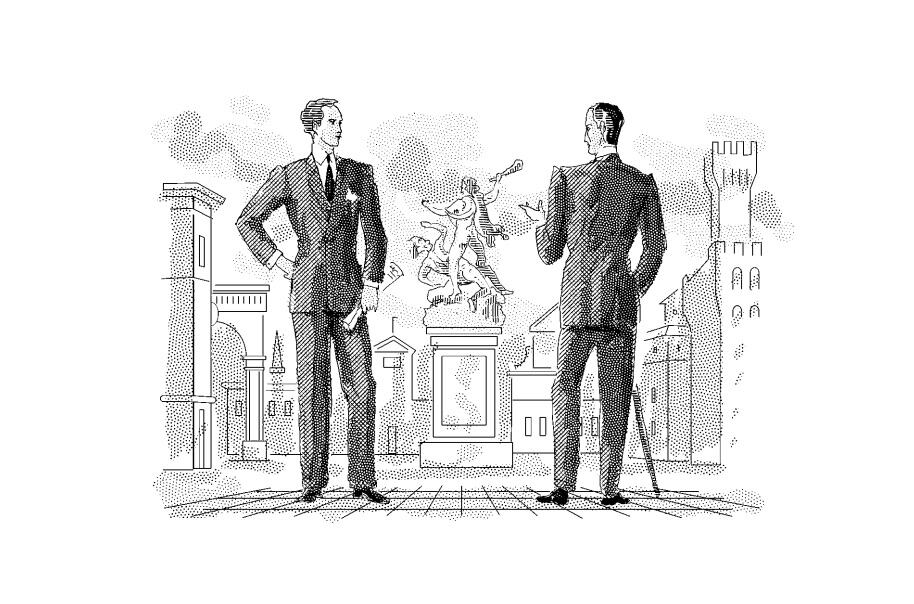Books Reviewed
Bewildered and intimidated out of ignorance, or perhaps dismissing the subject as effeminate, few American men are willing to give much thought to their attire. The result? All too often, no matter who wears the pants in a relationship, it is the woman who chooses the trousers. To help fix this deplorable situation, The Suit aims to provide the right kind of man with the knowledge and confidence to dress himself sharply.
Written by Nicholas Antongiavanni—the nom de plumage of a former speechwriter for George W. Bush, Condoleezza Rice, and Rudolph Giuliani—the book is a close imitation of Niccolò Machiavelli’s The Prince in both structure and style. Whereas Machiavelli penned his notorious handbook in the hopes of becoming an advisor to Lorenzo de’ Medici, Antongiavanni writes to offer his sartorial expertise to John Elkann, heir apparent to the Fiat dynasty and grandson of the Italian merchant prince Gianni Agnelli. Elkann has quite a legacy to uphold, since Agnelli was a famous coxcomb known for wearing his watch over his shirt cuff and pairing suits with (casual) button-down collar shirts—with the collar points unbuttoned, no less.
Just as Machiavelli boldly set forth the qualities a prince needed to obtain and maintain power, Antongiavanni recommends “dandification” as the virtù required at the highest reaches of business and politics, where it is survival of the best fitted. To those who would rule in these competitive worlds, Antongiavanni’s first and foremost counsel is to don a suit and tie, the timeless combination that reached its apogee in the 1930s. A triumph of design that harmoniously balances modesty and sexuality, conformity and individuality, simplicity in the whole with ornament in the details, the business suit is the perfect uniform for those who see their work as civilized combat. Indeed, long before anyone spoke of the “power suit,” bankers and lawyers on the streets of London could be seen going about like knights ready for battle, outfitted with armor (three-piece suit), helmet (bowler hat), sword (umbrella, never unfurled), and shield (copy of the Times). With this in mind, one should notice that the chief effect of business casual has been to strip men of the most aggressively masculine item in the Western wardrobe: the necktie.
Antongiavanni’s thorough advice, which includes specific recommendations for various body types, is largely spot on as a guide to looking like a captain, and not an ensign, of industry—at least for the pre-dot-com era. Ever the realist, his discerning judgments rise above partisan politics: George H. W. Bush was “ruined” by having dressed too preppily patrician in the White House, whereas Willie Brown, the former Democratic mayor of San Francisco, won “glory” with his double-breasted panache.
The Suit pays considerable attention to bespoke tailoring, which it esteems far above the less expensive options of made-to-measure (which merely alters pre-existing patterns) and ready-to-wear. Not only does a pilgrimage to Savile Row or its Neapolitan counterpart permit the greatest personalization and hence the best possible fit, it affords the pleasures of patronizing highly skilled Old World artisans, complete with their antiquated diction (“linen” for shirt cuff, “scye” for armhole) and formality (“Sir, would you kindly step through?”). It is curious that although custom tailoring would appear to permit the greatest individuality and risk-taking—to the point of outlandishness—it has in fact been a bulwark of sartorial conservatism. Though this can be attributed partly to self-selection by the clientele, one must not forget the salutary role of the dutiful tailor, who politely but firmly steers customers away from any gaucheries.
* * *
That Antongiavanni is a clotheshorse himself, the sort of man who can get a contact high from caressing a yard of vicuña, helps to explain the most distinctive and daring aspect of his book: holding up the dandy as its ideal. In fact, it was originally titled The Dandy, but the publisher thought better of it. Not only has that word been tainted in America ever since the first taunt of “Yankee Doodle,” but in the minds of most people the dandy is an aristocratic figure, an idle, frivolous aesthete who lords his exquisite taste over others. Ostentation might be acceptable for singular figures in solitary pursuits—think, for instance, of writers, such as Max Beerbohm and Tom Wolfe, who have been dandies in person and in print (“prose-horses” one might call them). But as Benjamin Franklin could have advised, men of enterprise need to project an image of thrift, industry, and self-restraint. The author is aware, of course, that many of the great historical dandies, Beau Brummell included, ended up disgraced, dissolute, and exiled due to unpaid debts. Sobriety was never their strong suit. In the face of all of this, Antongiavanni does his best to rehabilitate both the word and the ideal: “[T]he dandy is the enemy of the splendiferous and effeminate. He…favors simple clothes, pristine in cut, immaculate in fit,… never ostentatious, always manly….”
While the conceit of this book is a clever one, it perhaps goes too far in treating its original not just as a source of inspiration but as a pattern book. Hewing closely to Harvey C. Mansfield’s translation of The Prince, The Suit imitates many of Machiavelli’s puzzling stylistic idiosyncrasies, including his brazen grammatical transgressions. Antongiavanni is to be commended for defending classic men’s wear against the whims of fashion and the ravages of business casual, but his book in praise of elegance might have achieved even greater refinement had its prose been bespoke rather than made-to-measure.




